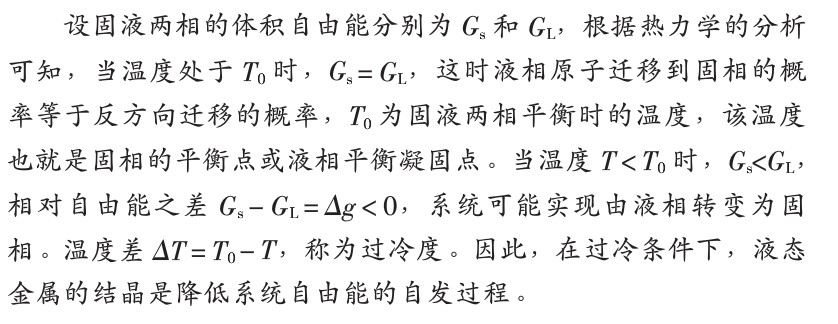So far, except for a few alloys under ultra-high speed cooling conditions (10 6 to 10 8 C/s), solidification is amorphous, almost all liquid metals (including alloys) are in normal cooling Under the conditions, all of them are transformed into crystals, and the solid-liquid transition process is the crystallization process.
The essence of the liquid metal crystals is the migration of near-ordered liquid phase structures by means of atoms in the microscopic scale, and they are stacked in a remotely-ordered crystalline solid state. Therefore, the crystallization process is a phase change, and its thermodynamic stability can be measured by the relative free energy
1. Phase change driving force Under isothermal equal pressure or isothermal equal volume conditions, the system always changes from a state of high free energy to a state of low free energy spontaneously. The greater the difference in free energy, the greater the phase change driving force
Set the volume free energy of solid and liquid phases as ', and GL respectively. According to the thermodynamic analysis, when the temperature is at To, Gw = Gr, then the probability that the liquid atoms will migrate to the solid phase is equal to the probability of migration in the opposite direction. To is the temperature at which the solid-liquid two-phase equilibrium occurs. This temperature is also the equilibrium point of the solid phase or the equilibrium freezing point of the liquid phase. When temperature T < To, Gs 1. Nucleation nucleation There are generally two types of nucleation: homogeneous nucleation and heterogeneous nucleation. Homogeneous nucleation refers to the nucleation process in a homogeneous melt without any external interface. Heterogeneous nucleation refers to the process of nucleation in a heterogeneous melt by relying on foreign materials or the substrate provided by the wall interface. The homogenization nucleation mechanism must have the following conditions: 1 there is a phase fluctuation in the supercooled liquid to provide a solid-phase crystal nuclei; 2 the nucleus causes a decrease in the volume free energy and an increase in the interfacial free energy. For this reason, the embryo needs a volume. Achieve a certain size can be stable existence; 3 subcooled melt in the presence of energy fluctuations and temperature fluctuations to provide critical nucleation work; 4 in order to maintain nucleation work requires a certain degree of undercooling. The reason why homogenous nucleation is more difficult to achieve is that it is generally difficult to completely eliminate the influence of foreign interfaces during the crystallization of actual metals, and it is therefore impossible to avoid the heterogeneous nucleation process. One of the most common methods of controlling nucleation in foundry production is to add a nucleating agent to the liquid metal to promote heterogeneous nucleation to achieve grain refinement and improved performance. A good nucleating agent should first ensure that the crystalline phase forms the smallest possible wetting angle on the substrate material, and that the secondary nucleating agent should also remain as stable as possible in the liquid metal and have the largest surface area and The best surface characteristics 2. After the nucleus grows up, it is the growth process. During the crystal growth process, the atoms in the liquid are successively piled up on the surface of the crystal, and the crystal grows continuously. The solid-liquid interface advances into the liquid phase. In the above process, from the microscopic point of view, the atom migration is bidirectional, from the liquid phase to the solid phase, but also from the solid phase to the liquid phase. If the amount of migration from the liquid phase to the solid phase atoms is greater than the migration from the solid phase to the liquid phase atoms, macroscopically, crystal growth occurs; otherwise, it appears as crystal melting.
Solar Ground Screw we spread as one of the related solar energy product is very hot product on East-South countries and Europe countries. It is used by supporting solar panel brackets, Solar Mounting System, Solar Ground Mounting System and Ground Screw Mounting System. Building one solar energy plant on the ground, we recommend you to using solar ground screw as supporting , the U shape steel as the structures and solar panel as the main. Generally, we take the length 1600-2500mm and the diameter 76-114mm of solar Ground Screw Piles to ground solar mounting systems. According to your solar project detail plan, we will supply you the suited ground screw and if you don`t know how to choose, please contact us.
 In the process of nucleation and growth, the formation of a curved solid-liquid interface is involved, resulting in the interfacial tension effect and the generation of microscopic heat flow. The alloy solution also contains the diffusion of microscopic solute.
In the process of nucleation and growth, the formation of a curved solid-liquid interface is involved, resulting in the interfacial tension effect and the generation of microscopic heat flow. The alloy solution also contains the diffusion of microscopic solute. 
Solar Foundations
Ground Screw With Flange,Ground Screw Pile With Flange,Security Ground Screw,Security Ground Screw Anchor
Hebei Honde Industrial Trade Imp&Exp Co., Ltd. , http://www.groundscrewpile.com